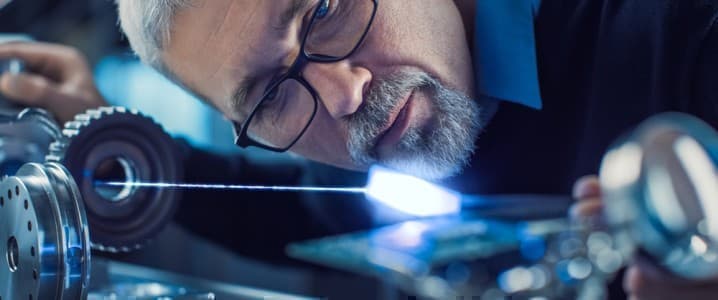Researchers at the Vienna University of Technology discovered excellent thermoelectric properties of nickel-gold alloys. These can be used to efficiently convert heat into electrical energy.
The researchers have published their results in the journal Science Advances.
Thermoelectrics enable the direct conversion of heat into electrical energy – and vice versa. This makes them interesting for a range of technological applications. In the search for thermoelectric materials with the best possible properties, a research team at TU Wien investigated various metallic alloys. A mixture of nickel and gold proved particularly promising.
Using thermoelectrics to generate electricity is nothing new. Since the middle of the 20th century, they have been used to generate electrical energy in space exploration, but thermoelectrics are also used in everyday applications such as portable refrigerators. Moreover, they could also be used in industrial environments to convert waste heat into green electricity, to name just one of the potential applications.
How thermoelectricity works
The thermoelectric effect is based on the movement of charged particles that migrate from the hotter to the colder side of a material. This results in an electrical voltage – the so-called thermoelectric voltage – which counteracts the thermally excited movement of the charge carriers. The ratio of the built-up thermoelectric voltage and the temperature difference defines the Seebeck coefficient, named after the German physicist Thomas Johann Seebeck, which is an important parameter for the thermoelectric performance of a material. The important requirement here is that there is an imbalance between positive and negative charges, as they compensate each other.
“Although Seebeck discovered the thermoelectric effect in common metals more than 200 years ago, nowadays metals are hardly considered as thermoelectric materials because they usually have a very low Seebeck coefficient,” explained Fabian Garmroudi, first author of the study. On the one hand, metals such as copper, silver or gold have extremely high electrical conductivity; on the other hand, their Seebeck coefficient is vanishingly small in most cases.
Nickel-gold alloys with outstanding properties
Physicists from the Institute of Solid State Physics (TU Wien) have now succeeded in finding metallic alloys with high conductivity and an exceptionally large Seebeck coefficient. Mixing the magnetic metal nickel with the noble metal gold radically changes the electronic properties. As soon as the yellowish color of gold disappears when about 10 % nickel is added, the thermoelectric performance increases rapidly. The physical origin for the enhanced Seebeck effect is rooted in the energy-dependent scattering behavior of the electrons – an effect fundamentally different from semiconducting thermoelectrics. Due to the particular electronic properties of the nickel atoms, positive charges are scattered more strongly than negative charges, resulting in the desired imbalance and hence a high thermoelectric voltage.
“Imagine a race between two runners, where one person runs on a free track, but the other person has to get through many obstacles. Of course, the person on the free track advances faster than the opponent, who has to slow down and change direction much more often,” compared Andrej Pustogow, senior author of the study, the flow of electrons in metallic thermoelectrics. In the alloys studied here, the positive charges are strongly scattered by the nickel electrons, while the negative charges can move practically undisturbed.
Record breaking material
The combination of extremely high electrical conductivity and simultaneously a high Seebeck coefficient leads to record thermoelectric power factor values in nickel-gold alloys, which exceed those of conventional semiconductors by far. “With the same geometry and fixed temperature gradient, many times more electrical power could be generated than in any other known material,” explained Fabian Garmroudi. In addition, the high power density may enable everyday applications in the large-scale sector in the future. “Already with the current performance, smartwatches, for instance, could already be charged autonomously using the wearer’s body heat,” Andrej Pustogow gave as an example.
Nickel-gold is just the beginning
“Even though gold is an expensive element, our work represents a proof of concept. We were able to show that not only semiconductors, but also metals can exhibit good thermoelectric properties that make them relevant for diverse applications. Metallic alloys have various advantages over semiconductors, especially in the manufacturing process of a thermoelectric generator,” explained Michael Parzer, one of the lead authors of the study.
The fact that the researchers were able to experimentally show that nickel-gold alloys are extremely good thermoelectrics is no coincidence. “Even before starting our experimental work, we calculated with theoretical models which alloys were most suitable,” revealed Michael Parzer. Currently, the group is also investigating other promising candidates that do not require the expensive element gold.
***
Two takeaways from this news are first a massive improvement in productivity is at hand. Then there is the record power factor in a scenario that is different from the semiconductor sets now making some market progress.
Most encouraging is that work is underway to find and prove up much less costly metal alloys to build thermoelectric units.
Mostly an “out of sight” harvesting system, thermoelectric has immense potential. The amount of wasted heat is simply a stunning number in all applications. The idea that the temperature variation from ambient air to skin temperature could power small personal electronics is a head turning idea.
By Brian Westenhaus via New Energy and Fuel
More Top Reads From Oilprice.com:
- The Next Hurdle In Armenia And Azerbaijan's Contentious Negotiations
- Gold And Silver Prices Teeter Near Support Zones
- European Demand Dilemma Delays Azerbaijan Gas Export Boost


















